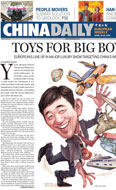Riding the rails in Shanghai
Updated: 2011-04-15 12:40
By Gao Changxin (China Daily European Weekly)
Shanghai's metro tops the global rankings, bigger than even the London Tube and New York Underground. But what is it like riding this subterranean dragon?
Shanghai's subway network has been expanding at break-neck speed. To see if its amenities have kept pace with the rapid expansion to make for a comfortable ride, I spent 14 hours to hit nearly all of the 266 stops on all 11 lines.
At 6 am on Monday, I dived underground into the Zhongshan Road station on Line 8. The lights were all on, staff in position. As I had no idea how much I should pay for such a long ride, I asked an attendant in the ticket office.
I was shocked to find that if I got out from the same station I entered, all I needed to pay was 6 yuan (0.63 euro) - 3 yuan for the ticket and another 3 for breaking the three-hour travel time limit. For a normal ride, the price ranges from 3 to 9 yuan, depending on how long and how far you travel.
I told the attendant my plan and consulted her on how I could finish my journey in the shortest time. The attendant, though obviously astonished by my plan, was nevertheless patient and hospitable, answering all my questions with a smile on her face.
Very few people were on the train as most commuters were still in bed at that early hour. But my carriage got more crowded and the numbers peaked at around 8:30 am, when I arrived at People's Square station, the interchange where lines 1, 2 and 8 meet. It's supposed to be the busiest junction in Shanghai, handling a daily traffic of around 400,000.
Traffic was heavy, but orderly. The station was well-signposted and it was hard to lose your way, even for first-time riders.
Some lines, such as 1, 2 and 8, are extremely busy during rush hours, with people pushing past each other to catch the train, and the automatic doors slide several times before they manage to close.
Off-peak, it's easier to get a seat, and during my 14 hours on the trains, I managed to get a seat about two-thirds of the time.
On most of the lines, there are protective doors on the platform to prevent people from falling onto the rail, and the gap between platform and train is only about 15 centimeters or less. There are few safety issues, even when the trains are busiest.
When you travel on the trains in the morning, you can get breakfast and a morning paper. The free newspaper Metro Express is available at dedicated newsstands, and vending machines at the stations dispense breakfast, selling hot and cold drinks and snacks. They take both coins and notes, though you have to figure out how to use them if it's your first time.
Convenient stores and small shops are in some stations, lined up just outside the turnstiles.
The air-conditioning system is generally good - cool enough to take the heat off rush hours and warm enough so you don't freeze on a long journey.
There are television screens both on the platform and in the trains. But those on the trains are generally unwatchable because the signals go on and off and there is no sound. Mobile phone signals are not good, either, and I gave up surfing on my phone after losing patience with the intermittent signals.
There are lifts, reserved for the disabled and elderly, but facilities for the physically-challenged are still not provided at all stations.
But the most dangerous encounter on the trains is still the gaggle of middle-aged women with heavy Shanghainese accents who bulldoze through you for the next available seat
E-paper

Han me downs
Traditional 3,000-year-old clothes are making a comeback.
Reaching out
Fast growth fuels rise in super rich
Chinese tourists spend more
Specials

Share your China stories!
Foreign readers are invited to share your China stories.

No more Mr. Bad Guy
Italian actor plans to smash ‘foreign devil’ myth and become the first white kungfu star made in China.

Art auctions
China accounted for 33% of global fine art sales.
